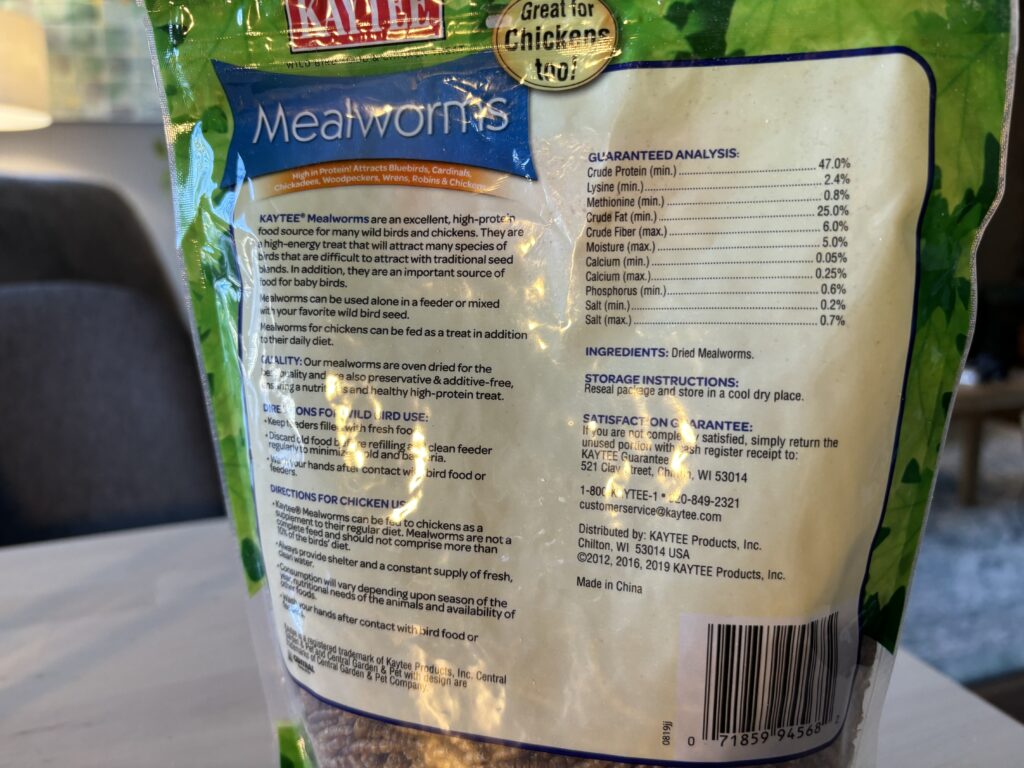I recommend black oil sunflower seed, suet, and safflower seed for those getting started with bird feeding. But, I’ve also started experimenting with mealworms. They’re a great source of protein and calcium, which is especially important for birds during the spring nesting season (Cornell Bird Lab). I usually buy Kaytee Dried Mealworms online as a convenient way to stock my feeders and wanted to write a quick review on why I like them.
Read on for my deep dive on this product. I’ll be posting some pictures along the way, so you can judge if this is something you’d like to try. At the end of this post, I’ll also put links for shopping.
Related Content: Cardinals Love this Dirt Cheap Bird Seed
Disclaimer: Some links found on this page are Amazon affiliate links. If you click an affiliate link and make a purchase, I might earn a commission. As an Amazon Associate I earn from qualifying purchases.
Why I Like Kaytee Mealworms

Mealworms are the larva of mealworm beetles. You can feed bids mealworms from a tray, hopper or specialized mealworm bird feeder.
Mealworms are an often overlooked food for bird feeding. If you haven’t tried adding any to your feeding station, it’s worth experimenting with. A lot of birds primarily eat insects or include them in their diet. Adding mealworms to your feeders is an easy way to draw in more species.
Click here to view and buy this product.
I usually offer mealworms at my feeders in March and use them through June. But, you can certainly use them year-round. Just be sure to also offer birds something high-fat, like suet or sunflower seeds in the winter.
I either mix mealworms with white millet and/or sunflower chips for a “spring migrant birds blend”, or I serve it straight up in a feeder. I usually find that Chickadees, Downy Woodpeckers, and Northern Cardinals really enjoy them.
Related Content: The Best and Worst Bird Seed at Target
I love Kaytee Mealworms because it’s easy for me to buy them from Amazon or my local Ace Hardware store. Wild Bird stores will sell live mealworms, but dried mealworms are cheaper and easier to store.
Birds That Will Like Kaytee Mealworms:
Here are the birds that will enjoy eating mealworms at a feeder. I’m linking to each birds page on the Cornell Bird Lab below, so you can learn more about each and check if you’re in their range.
- American Robins (rarer – they prefer live mealworms)
- Black Capped Chickadees
- Carolina Chickadees
- Carolina Wrens
- Downy Woodpeckers
- Eastern Bluebirds (rarer – they prefer live mealworms)
- Hairy Woodpeckers
- Northern Cardinals
- Red-Breasted Nuthatches
- Tufted Titmice
- White-Breasted Nuthatches
A Closer Look at the Back of Kaytee Mealworms

There are no filler ingredients in Kaytee Mealworms. You can also see for yourself in the picture above that mealworms are a fantastic source of protein for birds.
Where to Buy Kaytee Mealworms
Here are a list of places online you can buy a bag of Kaytee Mealworms:
Kaytee also has a store locator on their website. You can plug in your zip code and see stores selling mealworms nearby.
If you end up buying these mealworms, let me know in the comments section below what you think of it. If you have questions or comments, I always welcome those: debaundan@gmail.com

Pingback:Ranking Bird Seed from Worst to Best - BIRD BITES
Pingback:What You Need to Know to Attract Baltimore Orioles -